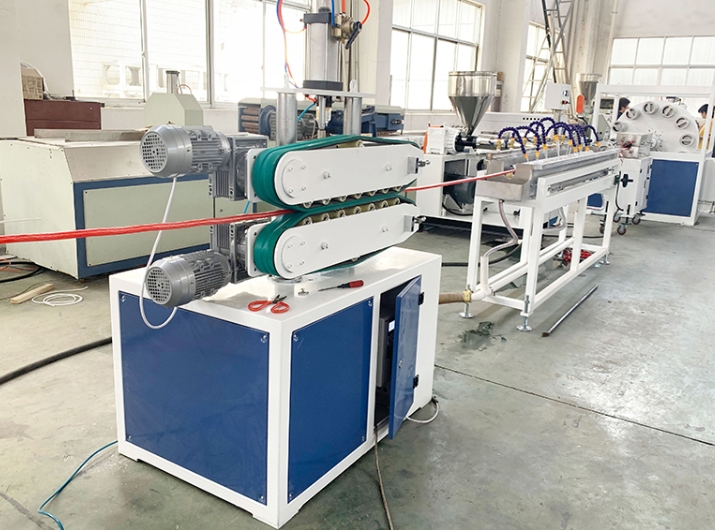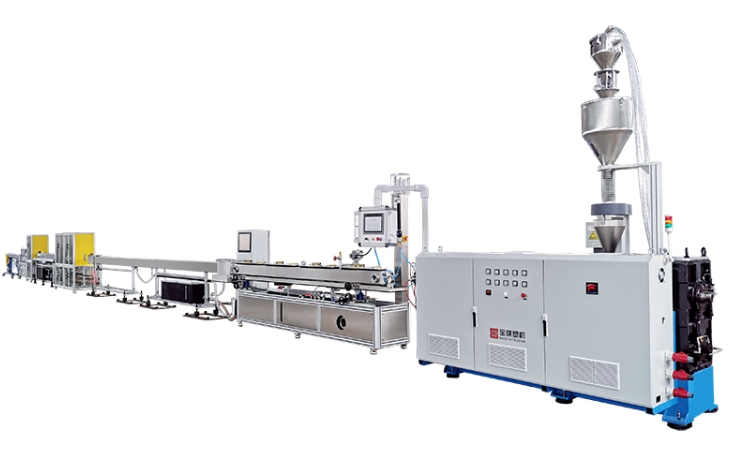Content Menu
● Understanding Foam Sheet Extrusion Equipment
>> Types of Foam Sheets Produced
● Why Invest in High-Quality Foam Sheet Extrusion Equipment?
>> 1. Superior Product Quality and Consistency
>> 2. Enhanced Production Efficiency
>> 3. Customization and Flexibility
>> 4. Cost-Effectiveness Over Time
>> 5. Environmental Benefits
● Key Features to Look for in High-Quality Foam Sheet Extrusion Equipment
>> Advanced Control Systems
>> Robust Mechanical Design
>> Efficient Cooling and Winding Systems
>> Energy Efficiency
● High Quality Foam Sheet Extrusion Equipment Price Overview
● How to Optimize the Efficiency of Your Foam Sheet Extrusion Line
>> Maintain Optimal Operating Conditions
>> Regular Maintenance
>> Use High-Quality Raw Materials
>> Invest in Automation and Monitoring
● Applications of High-Quality Foam Sheets
● Conclusion
● FAQ
>> 1. What factors influence the price of high-quality foam sheet extrusion equipment?
>> 2. Can foam sheet extrusion equipment produce different types of foam sheets?
>> 3. How does automation improve foam sheet extrusion?
>> 4. What are the environmental benefits of using high-quality foam sheet extrusion equipment?
>> 5. How can I maintain my foam sheet extrusion equipment for optimal performance?
● Citations:
Foam sheet extrusion equipment plays a pivotal role in producing foam sheets used across various industries such as packaging, automotive, construction, and insulation. Investing in high-quality foam sheet extrusion equipment is a strategic decision that can significantly impact production efficiency, product quality, and long-term profitability. This comprehensive article explores why such an investment is worthwhile, covering key benefits, cost considerations including high quality foam sheet extrusion equipment price, technological advancements, and practical tips for optimizing extrusion lines.

Understanding Foam Sheet Extrusion Equipment
Foam sheet extrusion equipment is designed to transform raw polymer resins like polyethylene (PE), expanded polyethylene (EPE), polypropylene (EPP), and polystyrene (EPS) into lightweight, flexible foam sheets. The process involves melting the resin, mixing with blowing agents, and extruding it through dies to form sheets with specific thickness, density, and width.
Types of Foam Sheets Produced
- EPE (Expanded Polyethylene): Known for cushioning, shock absorption, and water resistance.
- PE Foam: Lightweight with excellent insulation and cushioning properties.
- EPP (Expanded Polypropylene): Durable and impact-resistant.
- EPS (Expanded Polystyrene): Rigid foam used mainly for packaging and insulation.
Each type requires specialized extrusion equipment tailored to its material properties and intended application.
Why Invest in High-Quality Foam Sheet Extrusion Equipment?
1. Superior Product Quality and Consistency
High-quality extrusion lines ensure precise control over critical parameters such as temperature, pressure, and screw speed. This precision results in foam sheets with consistent density, thickness, and surface finish, which are essential for meeting stringent industry standards and customer expectations. For example, ALEMO's foam extrusion lines deliver consistent product quality regardless of operator skill by maintaining stable machine parameters and raw material recipes[7].
2. Enhanced Production Efficiency
Advanced extrusion equipment incorporates automation and sophisticated control systems that optimize the extrusion process. Features like PLC touch screens, real-time monitoring, and programmable tension control reduce human error and downtime, thereby increasing throughput. Sunwell Global's foam sheet extrusion lines offer output capacities ranging from 150 kg/h to 1000 kg/h with tandem extruders and energy-efficient drives, demonstrating how technology boosts productivity[2][12].
3. Customization and Flexibility
High-quality machines allow manufacturers to adjust foam sheet specifications such as thickness (0.2 mm to over 10 mm), width (up to 3 meters or more), and density (as low as 14 kg/m³ for EPE). This flexibility enables the production of tailored foam sheets for diverse applications—from delicate packaging to automotive insulation—maximizing market opportunities[4][10].
4. Cost-Effectiveness Over Time
Although the high quality foam sheet extrusion equipment price may seem substantial initially (ranging approximately from $29,000 to over $150,000 depending on model and capacity), the long-term savings are significant. Efficient machines reduce raw material waste, lower energy consumption (less than 0.3 kWh per kg produced in some models), and minimize labor costs through automation[4][14]. Moreover, durable equipment reduces maintenance expenses and downtime.
5. Environmental Benefits
Modern extrusion lines are designed to be eco-friendly. They use recyclable raw materials like EPE foam, which is 100% recyclable and reusable, reducing environmental impact[1][13]. Efficient energy use and reduced waste generation during production also contribute to sustainability goals.

Key Features to Look for in High-Quality Foam Sheet Extrusion Equipment
Advanced Control Systems
- PLC or touchscreen interfaces for easy operation.
- Automated adjustments for temperature, pressure, and speed.
- Real-time diagnostics and error detection.
Robust Mechanical Design
- Twin-screw or tandem extruders for better mixing and output.
- Bimetallic barrels for durability.
- Precision die heads with adjustable gaps for consistent sheet thickness.
Efficient Cooling and Winding Systems
- Air and water cooling systems to stabilize foam structure.
- Programmable tension control for uniform winding.
- Options for automatic cutting and reel changes.
Energy Efficiency
- Low power consumption drives (e.g., SIEMENS AC drives).
- Optimized screw designs to reduce shear and energy use.
High Quality Foam Sheet Extrusion Equipment Price Overview
Prices vary widely based on capacity, features, and manufacturer reputation:
| Model/Type | Price Range (USD) | Capacity (kg/h) | Thickness (mm) | Width (mm) |
| Basic EPE Foam Extruder | $29,000 - $45,000 | 25 - 50 | 0.2 - 3 | Up to 1600 |
| Mid-Range EPE Foam Extruder | $45,000 - $150,000 | 60 - 180 | 0.2 - 8 | Up to 3000 |
| High-End Tandem Extrusion | $100,000 - $168,000 | 150 - 700 | 0.5 - 6 | 700 - 3000 |
| Specialized Foam Lines (ALEMO, Sunwell) | Custom pricing, often $150,000+ | 150 - 1000 | 0.5 - 25 | Up to 3200 |
The price reflects advanced features, energy efficiency, and production capacity[2][4][5][14].
How to Optimize the Efficiency of Your Foam Sheet Extrusion Line
Maintain Optimal Operating Conditions
- Keep precise temperature, pressure, and speed settings tailored to resin type.
- Adjust extrusion die size and shape to achieve desired sheet thickness and density with minimal waste[6].
Regular Maintenance
- Clean and inspect equipment to prevent blockages and leaks.
- Replace worn parts promptly to avoid downtime.
Use High-Quality Raw Materials
- Use resin pellets optimized for extrusion.
- Ensure consistent material feed to avoid defects.
Invest in Automation and Monitoring
- Employ sensors for real-time process feedback.
- Use automated controls to adjust parameters dynamically.
Applications of High-Quality Foam Sheets
- Packaging: Cushioning fragile goods, electronics, and appliances.
- Automotive: Heat insulation, noise reduction, and cushioning.
- Construction: Thermal insulation panels and soundproofing.
- Sports and Leisure: Protective padding and mats.
- Agriculture: Protective layers and cushioning in transportation.
Conclusion
Investing in high-quality foam sheet extrusion equipment is a smart move for manufacturers aiming to produce superior foam sheets efficiently and sustainably. Despite the initial high quality foam sheet extrusion equipment price, the benefits of enhanced product quality, production flexibility, operational efficiency, and environmental friendliness deliver substantial long-term value. Advanced technology and automation further optimize production, reduce waste, and lower operational costs. For businesses seeking to expand or upgrade their foam sheet manufacturing capabilities, prioritizing quality equipment is essential to remain competitive and meet evolving market demands.

FAQ
1. What factors influence the price of high-quality foam sheet extrusion equipment?
The price depends on production capacity, extrusion technology (single vs. twin screw), automation level, machine size, and brand reputation. Higher capacity and advanced features increase the cost[4][5][14].
2. Can foam sheet extrusion equipment produce different types of foam sheets?
Yes, modern extrusion lines can process various materials such as EPE, PE, EPP, and EPS, allowing production of foam sheets with different densities, thicknesses, and properties tailored to specific applications[2][7][10].
3. How does automation improve foam sheet extrusion?
Automation reduces human error, stabilizes production parameters, enables real-time monitoring, and optimizes energy use, resulting in higher quality products and increased efficiency[6][10].
4. What are the environmental benefits of using high-quality foam sheet extrusion equipment?
These machines often use recyclable raw materials and consume less energy, producing less waste. Foam sheets like EPE are 100% recyclable, supporting sustainable manufacturing practices[1][13].
5. How can I maintain my foam sheet extrusion equipment for optimal performance?
Regular cleaning, timely replacement of worn parts, monitoring operating parameters, and using quality raw materials help maintain efficiency and reduce downtime[6].
Citations:
[1] https://www.moldingmachinetepai.com/news/when-to-choose-epe-foam-sheet-extrusion-line-over-traditional-foam-extrusion.html
[2] https://www.sunwellglobal.com.tw/en/product/Foam-Sheet-Extrusion-Lines.html
[3] https://www.alibaba.com/showroom/foam-extrusion-equipment.html
[4] https://epe-machine.com/Epe_Foam_Extruder-Epe_Foam_Sheet_Extruder.html
[5] https://shunxiangmachine.en.made-in-china.com/product/eZctDmhxJvYA/China-150-PE-Foam-Sheet-Extrusion-Machine.html
[6] https://www.moldingmachinetepai.com/news/how-to-optimize-the-efficiency-of-your-epe-foam-sheet-extrusion-line-tips-and-tricks-revealed.html
[7] https://alemo.eu/foam-extrusion/
[8] https://www.jwellmachine.com/xpe-ixpe-foam-sheet-extrusion-line/
[9] https://hongrunmachine.goldsupplier.com/product.html?groupid=391433
[10] https://www.jwellextrusions.com/selecting-the-right-pe-foam-sheet-extrusion-line.html
[11] https://8705c7d7b417439e.en.made-in-china.com/product/RtPrZKjugaVY/China-EPE-Foam-Sheet-Extrusion-Machine-for-Packaging-Industry.html
[12] https://www.allplastix.com/product/foam-sheet-extrusion-line/
[13] https://www.moldingmachinetepai.com/news/why-epe-foam-sheet-extrusion-line-is-the-game-changer-for-product-packaging.html
[14] https://alemo.eu/foam-sheet-extrusion-line-alemo-ext130/
[15] https://www.jwellextrusions.com/transforming-raw-material-into-versatile-foam-sheets.html
[16] https://www.useon.cn/resources/Foam-Extrusion_2024_en.pdf
[17] https://www.extrusion.com.tw/en/about.html/advantages.html
[18] https://www.plasticwasterecyclingmachines.com/quality-13171492-pp-ps-foam-sheet-extrusion-machine
[19] https://cpanta.com.au/foam-extrusion/
[20] https://www.feiningercn.com/optimizing-ps-foam-sheet-production-key-insights-into-ps-foam-sheet-extrusion-line.html
[21] http://www.ytfuchang.com/products/jbyxpmsljcj/51.html
[22] https://www.plasticextrusion-machine.com/sale-26747254-high-quality-15mm-tpu-foam-sheet-extrusion-machine-with-shock-absorption.html
[23] https://www.useon.com/foam-extrusion/
[24] https://gdyaoan.en.made-in-china.com/product/zQAYytmOJBhl/China-High-Quality-15mm-TPU-Foam-Sheet-Extrusion-Machine-with-Shock-Absorption.html
[25] https://hzaochi.en.made-in-china.com/product/NogJZnEDayRt/China-105-PE-Foam-Sheet-Extrusion-Machine.html
[26] http://www.foamtech-korea.com/ps-foam-sheet-extrusion-line.html
[27] https://www.cbextrusion.com/foam-extrusion-line/
[28] https://royalstarmechanica.en.made-in-china.com/product/VxvUkzMuCcWX/China-Rsd-180-PE-Foam-Sheet-Extrusion-Machine-of-High-Quality.html
[29] https://www.indiamart.com/proddetail/pe-foam-sheet-extrusion-machine-10933587673.html
[30] https://pepsfoammachinery.goldsupplier.com/349685-Ps-foam-sheet-extruder/






















